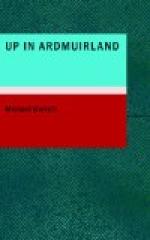Most of the houses of Ardmuirland are constructed on exactly the same plan. There are two principal rooms—“but” and “ben,” as they are commonly designated. (It is unnecessary here to dive into etymology; but it may be noticed in passing that but signifies “without” and ben “within.”) To “gae ben” is to pass into the inner room, which at one time opened out of the ordinary living apartment or kitchen, but is now usually separated from it by a little entrance lobby. Besides these two chief rooms, the initiated will be able to point out sundry little hidden closets and cupboards, fitted up as sleeping apartments, and reminding one of the contrivances on board ship. The two rooms each contain a more demonstrative bed, as a rule: but in some cases the bed is shut up with panelled doors like a cupboard.
All that I learned from Bell about the Ardmuirland of bygone days was gathered from her lips at intervals, and in the course of many repeated visits; for it would have been fatal to my purpose had I allowed her to imagine that I intended to make public use of her communications. Though I have retained the substance, I have often altered the form; for it would be useless to expect the reader to translate (if it were even possible to do so without the help of a glossary) Bell’s broad Scots dialect. Yet the temptation has been too great to be resisted from time to time to quote her exact words—so quaint her diction and, to me at least, so attractive withal.
A description of the original chapel of the district will serve as a fitting introduction to these memoirs. According to Bell, it must have been simple even to destitution. No smoothly hewn stones, no carved windows, no decoration of any kind distinguished it from the houses of the people. It was a small, low building of rough stone, unplastered, even inside, and roofed by a heather thatch. There was a single door in the side wall. The roof within was open to the rude, unvarnished beams which upheld the thatch. The floor was of beaten clay, and there were rough benches for the people to sit upon during the sermon, but no contrivance for kneeling upon.
“Some o’ the fowk had boards to kneel on, ye ken,” Bell explained, “but the maist o’ them prayed kneelin’ on the flure.”
The altar was a plain, deal kitchen table, devoid of all ornament in the shape of draperies except the necessary linen coverings. Underneath it was a box, within which the vestments were stowed away; for there was no semblance of sacristy, and the priest’s house was some yards distant. At the opposite end from the altar was a raised dais for the accommodation of the singers, of whom Bell herself was one. She could not recall what they were accustomed to sing as a rule.
“I mind we wad sing the Dies Irae, whiles,” was all the information she could give on that point. One would think it scarcely possible that so penitential a chant could form the usual musical accompaniment to Sunday Mass! A teacher of music from a neighboring glen used to come over from time to time to practise the singers.




